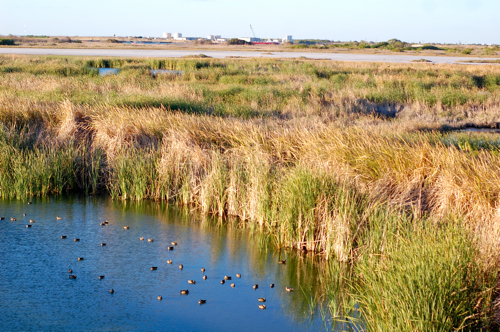
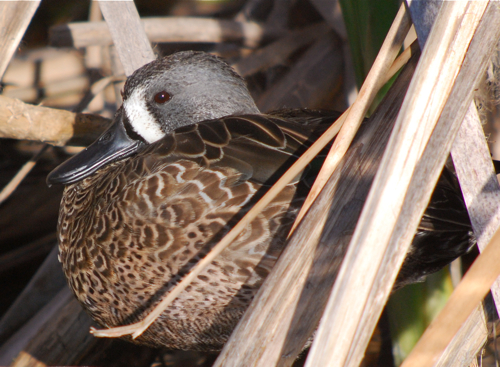
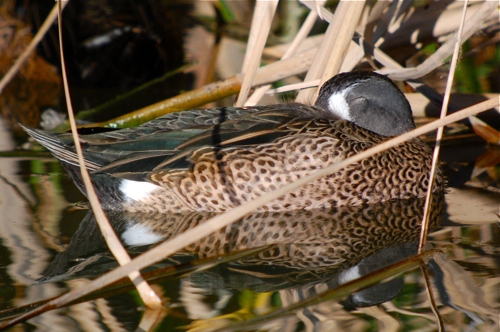
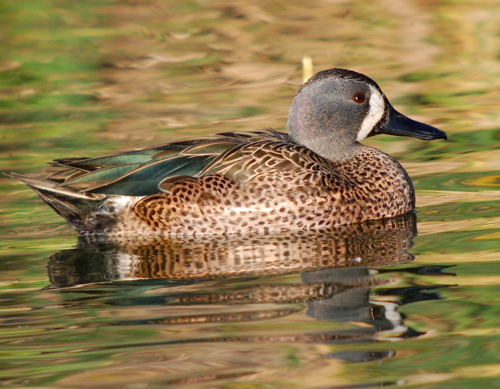
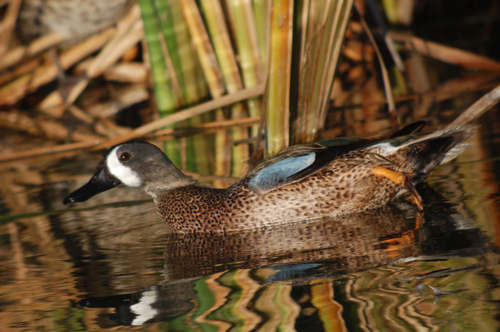
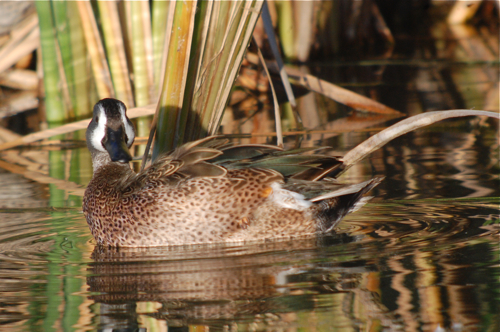
Birdchick Blog






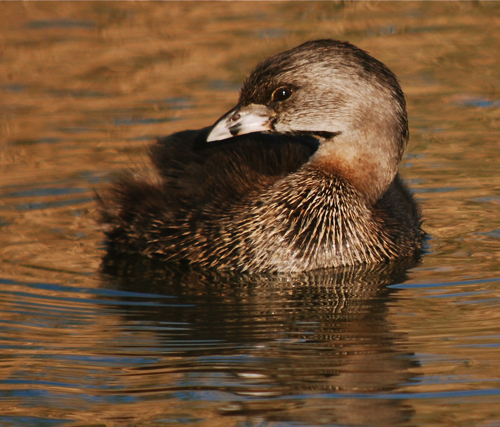 One thing I love about visiting southern states is that some of the birds I see in Minnesota are so much more camera friendly. Pied-billed grebes are shifty in Minnesota, they don't trust anyone staring at them for too long or they submerge and resurface further away. While in Corpus Christi, my buddy Clay took me to a place with a ton of great waterfowl and some rather obliging grebes. The above bird is an adult pied-billed grebe.
One thing I love about visiting southern states is that some of the birds I see in Minnesota are so much more camera friendly. Pied-billed grebes are shifty in Minnesota, they don't trust anyone staring at them for too long or they submerge and resurface further away. While in Corpus Christi, my buddy Clay took me to a place with a ton of great waterfowl and some rather obliging grebes. The above bird is an adult pied-billed grebe.
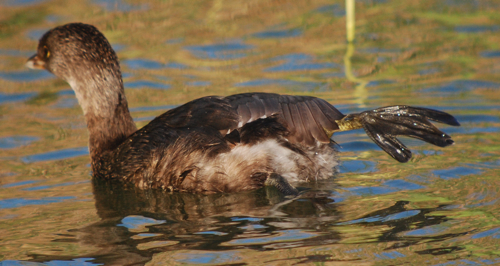
They even showed me their grebe toes. How do you like them apples, not webbed like a duck at all. Let's get a closer look:
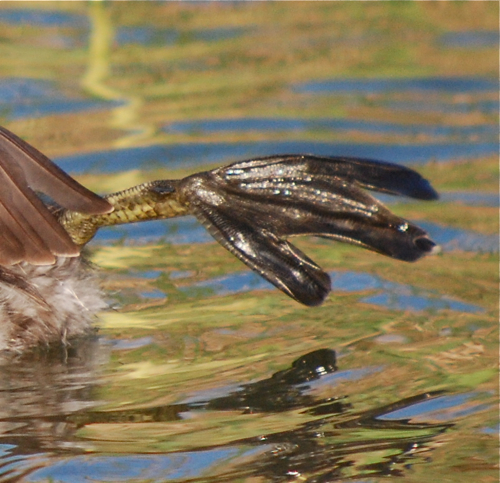
Look at that crazy foot...wonder if this will lead to a slew of foot fetish comments getting clogged in the blog spam filter? The feet of the grebe are far back on the body and the lobed toes do aid it as it swims underwater. They really can't walk on land very well. Ask yourself if you have ever seen one on land?
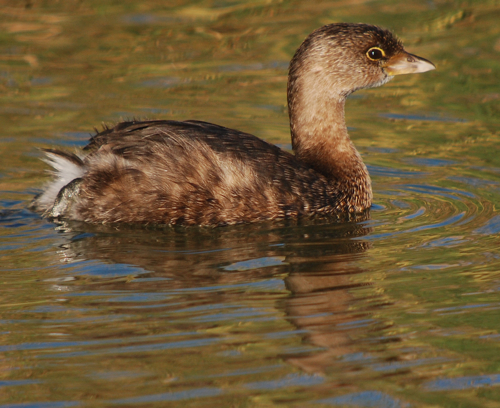
Here's a first year pied-billed grebe--it barely has any pie on its bill.
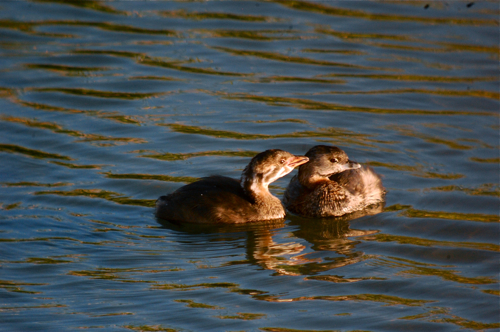
This grebe was so young that it still had the stripes on its face and was begging for food aggressively from its parent.
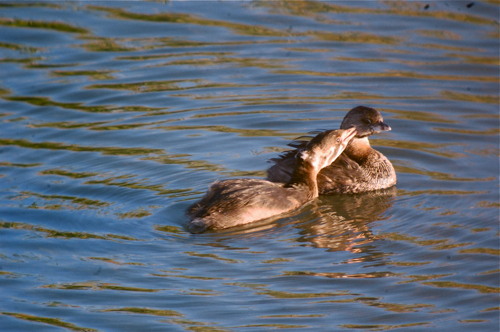
The adult bird was trying to preen its feathers, but the younger bird pecked and pecked while peeping in a high pitched tone incessantly. Periodically the adult would nonchalantly reach down, grab a minnow and hand it to the begging young and then go back to preening. I wonder how the adults teach the young to get their own food when the young are this aggressive when they are about the same size as the adult. Perhaps the adults just flee in terror of the incessant begging?
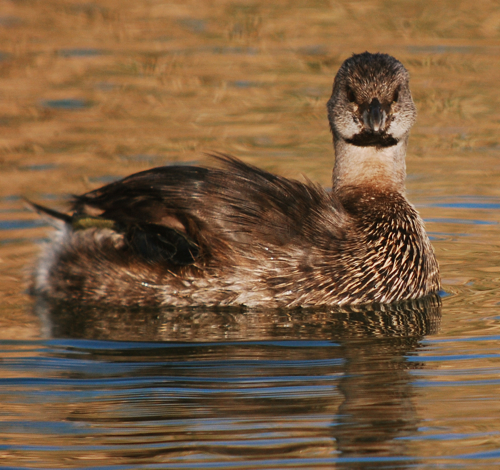
Anyway, it was fun to spend time with brown birds with freaky toes.
I'm going to start this post off with landscape shots that have a brown bird called a common pauraque in them. See if you can find the bird(s) and at the end of the post, I'll put up the photos pointing out where they are and you can see if you were able to find them.

Let's start with an easy one, there's one common pauraque in this photo.

There's one pauraque in this photo.

There's one pauraque in this photo.

This is the hardest one, but there sure is a pauraque in this photo.

There are actually 2 pauraques in this photo, one easy...one almost impossible.
Most of my birding time during the Rio Grande Valley Birding Fest was spent at Estero Llano Grande State Park. Partly because I love it but also because some of my other favorite birding sites in the area were closed due to flooding. I went there several times with both Birdspot and WildBird on the Fly. One of the target birds on the trails is a common pauraque, a nightjar that is similar to nighthawks and whip-poor-wills. I've heard them and I've seen them flushed on roads at night in Central America, but I've never seen a roosting pauraque.

I knew people were seeing between 1 - 3 at a time and I was hopeful we'd find more than one. We sure did, above is one of the pauraques. With that cryptic brown plumage, you can understand how they might be easy to miss. They are active at dawn and dusk and fly around to catch insects with their mouths wide open. Don't let that tiny beak fool you, it belies a mouth worthy of any mother-in-law.

The park rangers and other birders were very helpful to point out the general areas of where the nightjars were being seen, but you still had to some work. Here's the trail near alligator lake where they typically have been found roosting. Note the white sign, it warns people to stay on the trails so the pauraques do not get flushed. Note the pile of brush on the left side of the trail, that's where the pauraques were. I suspect the brush was placed there to encourage people to stay on the trail and not wander in looking for the birds and inadvertently flushing them.

Check it out: Disapproving Pauraque! We found one right away and I was happy for that. These nightjars were a challenge to digiscope. Number one: they were in the shade. I could get around that by using the timer on my camera and minimize camera shake for a long exposure. However, the second and the most challenging problem was that the birds were too darned close to focus in my spotting scope! The sticks that were protecting the pauraque roosting location blocked some angles and I wasn't about to move the sticks, they were there to help the pauraques. But with patience and creative angling, I managed to grab some shots.

As I was setting up the above digiscoped shot, I found a second and then a third, each closer than the last. The third pauraque we found was literally three feet away from the trail. Finding the pauraques reminded me of morel hunting. Once you find one, you instantly see all the other mushrooms surrounding you. It was the same with pauraques, once you found one, the other popped out like an image in a magic eye painting.

Many of the pauraque photos like the above bird were not digiscoped because they are just too close. I always wonder how many owls I pass under on a regular basis, not I wonder how many pauraqes, poor-wills and other nightjars I have almost stepped on in my birding travels. The pauraques did seem to be everywhere in South Texas. Birdspot and I were wandering around Frontera Audubon, watching a brown thrasher that was working some leaves, when all three of us--especially the thrasher jumped with a leaf toss flushed a pauraque. I wonder how often other birds flush nightjars. And I wonder if they are irritated because of the scare?
And now to see how you did with finding the pauraques in the first five photos:

Here's common pauraque number one. This one may have been too easy, that eye sticks out. But I walked past it at least twice before I finally realized it was three feet from the trail.

Hidden pauraque #2.

Pauraque nestled all snug among sticks.

I realize that even though it's circled, this pauraque is hard to see, so here is a zoom in of the cryptically plumaged nightjar:

Even up close, you can see how well their feathers work in their habitat!

The one in the front is fairly obvious, but the one in the back is really hard to see. Here's a close up:

See, there really is a parauque by those sticks!
Ah, nothing makes me as happy as looking for brown birds!

 These are some redheads bathing and splashing against the sunset at Leonabelle Turnbull Birding Center in Port Aransas, TX. I took this particular photo through my spotting scope. The redheads were not at the best sun angle, but with the splashing, I thought it was an arty shot.
These are some redheads bathing and splashing against the sunset at Leonabelle Turnbull Birding Center in Port Aransas, TX. I took this particular photo through my spotting scope. The redheads were not at the best sun angle, but with the splashing, I thought it was an arty shot.
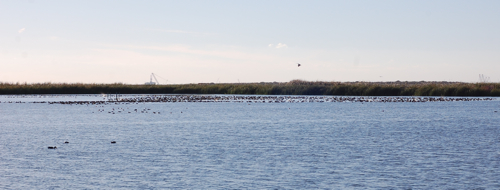
It was a huge flock of birds. At first glance I would have guessed 1500, but in the scope, the redheads just kept going. We estimated that there were close to 4000 redheads were in this raft. I half wondered if any of these birds had been counted on our aerial waterfowl surveys on the Upper Mississippi River.
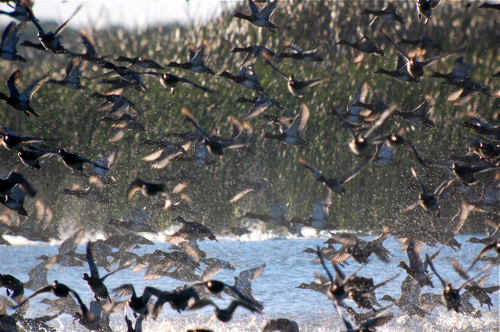
Suddenly, the flock of redheads took off.
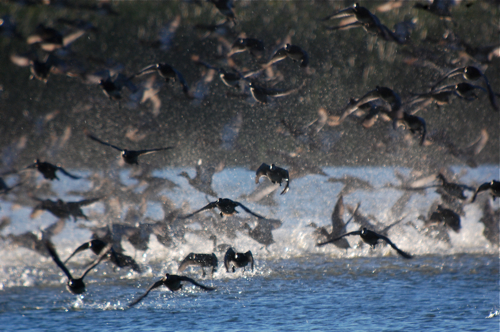
Something must have spooked them. There are warning signs about alligators around the boardwalk, so my guess is that an alligator went for a duck.
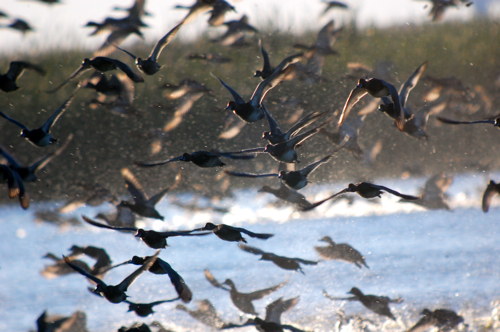
One of the benefits of being one for 4000 is that you are less likely to be the one nailed by a gator.
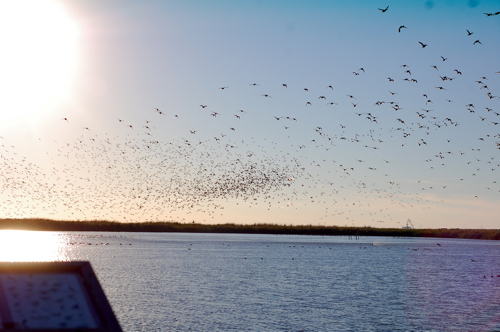
Once the flock what in the air, you could really get a sense of the size and agree that yeah, there must be close to 4000 birds there.
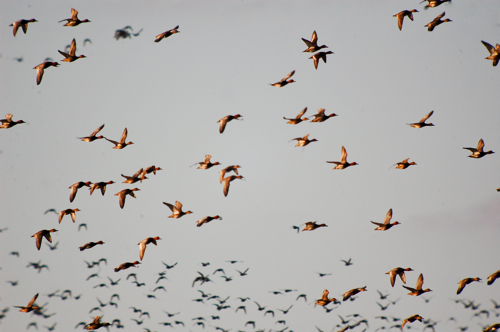
I couldn't help but notice other species mixed in with the flock and making mental notes. In the above photo there are a couple of scaup mixed in--can you pick them out? I still crack up that even though I was on vacation from my waterfowl surveys, I'm still attracted to ducks in large numbers.
My non birding New Orleans fun is finished and I'm back in Texas to enjoy some time with friends at the Rio Grande Valley Bird Festival.
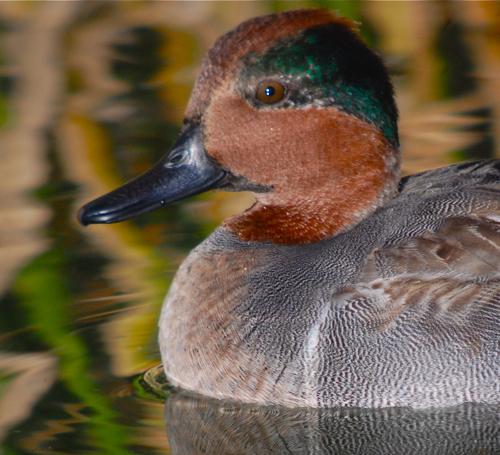
I had a brief love affair with a green-winged teal. I don't normally get the above view of a teal. Generally, they are fleeing from our plane when we count them. So to see a green-winged teal chilling in the evening sun was quite the treat.

At first glance, they may appear brown, but their heads rival any mallards with the rich rusty read accented by a swath of iridescent green behind the eye--like eye shadow gone wild. This is the smallest dabbling duck in North America, so besides the color, they are quite cute. They will forage for aquatic insects on the water's surface or dip below for vegetation.
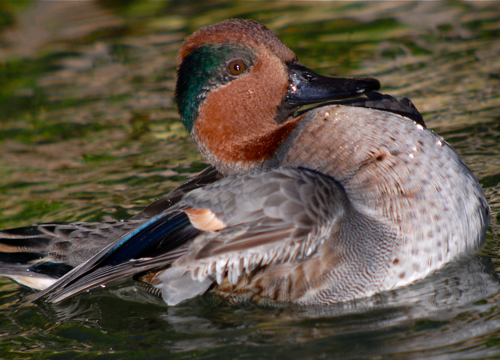
This bird went into full on bathing mode while I was digiscoping it. I think I will let the photos speak for themselves.

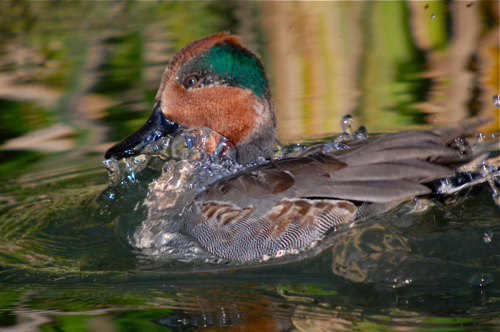
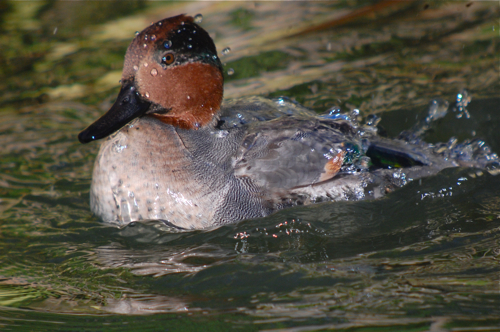

After a good bathe, a nice preen is in order. I love this shot, you can see the green patch from where the teal gets its name.
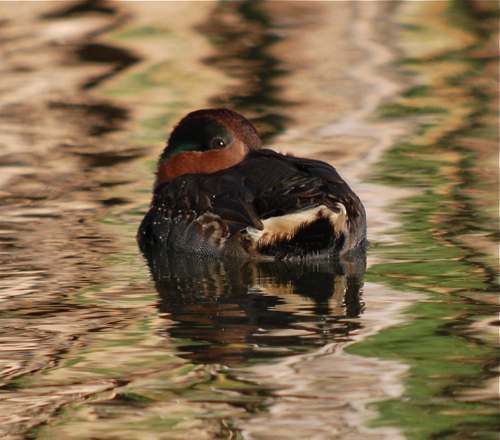
And then a nap.
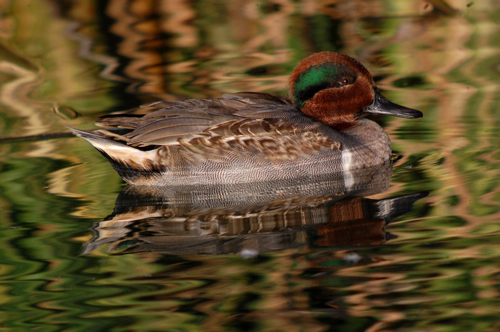
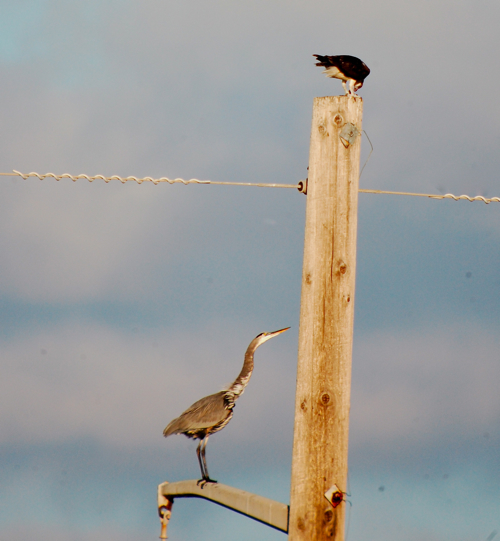 This great blue heron braved a telephone pole to see if it could steal from fish morsels from an osprey. It was not successful.
This great blue heron braved a telephone pole to see if it could steal from fish morsels from an osprey. It was not successful.
Here I am, on the first day of vacation in south Texas and what did I spend digiscoping?
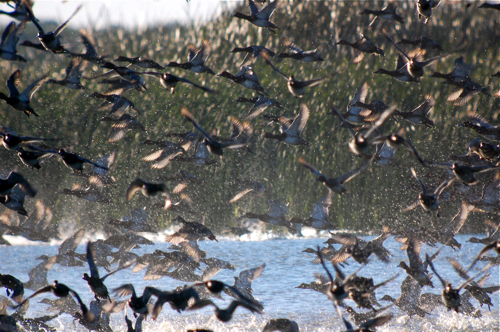
Ducks. Thousands of redhead ducks. Never mind that I count them for work this time of year. I still watched, photographed and counted them on my first day off.
I am a sick woman.
The Harlingen Airport is happy to see birders in Texas--look at the size of that banner! I feel so welcomed for the Rio Grande Valley Bird Festival.
We had the opening reception last night, which is a great time to reconnect with friends and eat some fancy foods. There was a new addition to the table--live birds. A small cage full of parakeets was put out by catering company (cause see, we're bird watchers). They startled the dickens out of me, but the budgies seemed to be having a great time preening each other and chirping sweet nothings.
I tried to get a photo of birders using a pair of tongs to get a budgie, but to no avail. I asked Jim from Kowa (above). "No way," he said, "your just going to put it in your blog that Kowa eats birds." He then went the extra mile to put his arm around the birds to prove how much he LOVES birds.
Kevin Karlson walked by and I shouted, "Yo, Kevin, do me a favor, put some tongs to the birds."
He also resisted my request, "No, you'll put it in your blog."
I even offered to say nice things about his books in the blog, but he said that I already do say nice things about his books and he appreciates that.
They're on to me!
So, by the time you are reading this, I'll be a digiscoping fool on the Bentsen-Rio Grande State Park. Then I give my Blogging: The New Nature Journal Program, then do a book signing, and then its Birds and Beers. Such a wild and exciting Thursday.
I've already touched based with several bloggers including Flying Mullet, Round Robin, and one third of 10,000 Birds. Will Mike Bergin sway me to the power of The Nature Blog Network...we shall see...
Oh, and bird banders will get a kick out of this:
Bird bites the cover of the book that identifies, ages and sexes them! And it's a house sparrow too! This sparrow latched on to the corner an would not let go, taking out its frustration on being man handled on poor, poor, hard to read Pyle.
Speaking of the Pyle book, there's a second one out. Yes, the bird id book with no photos, that even uses math equations to id birds, and is the necessary evil of every bander's operation now has a part 2! Here's an earlier post I had about Peter Pyle's Identification Guide To North American Birds and I had to chuckle, Ian Paulsen posted a few months ago: "I think every birder will want Pyle's Identification Guide to North American Birds: part 2!!!"
I hope he was kidding. Pyle is NOT for every birder, it's only for the masochistic Jedi birders that use The Force to identify birds. It's this heavy little book that sits on your back when you're sweating over a flycatcher in your hand and asking yourself if you'll be able to try to identify, let alone age and sex it. Then the book says in a gravelly drag queen voice, "No! Do or do not, there is no try."
Scariest bird book out there, I swear.
Really, it is. I swear. At least for this year.
Banding was slow today at Carpenter Nature Center and I spent the morning talking to the Development Director while she repaired nets. Fortunately, I had a chance to observe some banding while at the Rio Grande Valley Bird Festival. Once again, a Sunday morning trip was scheduled to watch bander Mark Conway (that's Mark in the above photo banding a kiskadee) and his assistants band birds at Los Ebanos Preserve.
Here's a closer shot of the kiskadee Mark was banding. Something interesting that I learned was that all kiskadees have a yellow gape.
 I took a photo of one earlier in the festival and I had never noticed that before and thought it was a young bird, but all kiskadees of all ages have that yellow outline at the corners of their mouths.
I took a photo of one earlier in the festival and I had never noticed that before and thought it was a young bird, but all kiskadees of all ages have that yellow outline at the corners of their mouths.
The first bird of the morning wast a gray phase eastern screech owl. The banders weren't targeting owls, but they had the nets up at not long after dawn and this bird was just flying through and flew into the net.
Here is a long-billed thrasher which I hear way more than see in when birding in South Texas. That bill is not deformed, that's the way they are.
The best part of the day was getting to see a green jay up close. Last year they banded quite a few and I figured that green jays were par for the course.
But Mark said that they don't get green jays in the nets very often as they are members of the corvid family and very intelligent. They had not banded at Los Ebanos recently so the birds were just not used to it.
Mark said that this set a record for the most green jays that they have ever caught in a day: 9 green jays banded--and I never got tired of them.
Another exciting bird of the day was an olive sparrow--one of the hardest birds to see, you hear them quite a bit. I was glad to have a chance to get this photo because, frankly, my earlier efforts were just plain sad:
 Behind all those tiny branches lurks an olive sparrow at Llano Grande. This was not bad, just finding an olive sparrow sitting on a branch long enough to aim your scope and camera is feat within itself.
Behind all those tiny branches lurks an olive sparrow at Llano Grande. This was not bad, just finding an olive sparrow sitting on a branch long enough to aim your scope and camera is feat within itself.
Here, Mark is holding an orange-crowned warbler. These guys are all over in the trees in south Texas this time of year. They're not an easy warbler to see, so when a guide finds one, I think people hear warbler and hope for an exciting/colorful bird. As they search and search, they'll say, "I see a small brownish bird..." Yep, that's the orange-crowned. It's not even as orange as a blackburnian warbler. You may be wondering to yourself, why this bird is called an orange-crowned warbler...
Here, Mark demonstrates the name. When you hold and orange-crowned warbler about six inches from your face and blow on its crown, you can see a kind of orangish color on the underside of the crest feathers--see how obvious that is? Another one of those birds that was named when bird watching was done with a gun, not with binoculars.
Here are one of the many great-tailed grackles in the area. When you get them in the sun, they really are a striking bird. You can hear great-taileds singing all over Harlingen, any time of day--even all night long when they are roosting in the trees--how do those guys get any rest?
They do sound incredibly mechanical as opposed to musical. I wonder how that adaptation sounded, and what must have early explorers to North America have thought hearing those things chatter all night in the trees above them?
There was also a very exciting bird into the nets--a common yellowthroat, which to Mark are not common but something to study in depth. He thinks that there is an isolated population of yellowthroats that could be a subspecies that he calls the Brownsville yellowthroat. Will there a split some day separating this species of yellowthroat from the rest of the common yellowthroats seen around the United States? If so, Mark will have been instrumental in that research.
Okay, this doesn't have too much to do with banding, but there were quite a few anoles running around during the banding program and this guy with the wavy tail caught my eye. I wondered what happened to make it look like that? Did appear to slow it down in its daily travels.
And so, I leave you wit one final green jay photo, because they are just so darn cool looking. I'm very excited, it looks like we will be able to go out with Mark one day on the South Texas trip next year, which would be awesome for the group and great for me to learn different banding techniques from different people.
 Okay, finally the word on what happened people-wise at the Rio Grande Valley Bird Festival.
First of all, there were more kids at this festival than any I had seen before. These two guys were so cute, they came to get outfitted for a field trip. They selected Energy Binoculars, which fit well in kids hands and on kid faces. They were so cute, as Ben (tall guy behind the boys) was taking the binos out of the box and putting the straps on, one of the boys exclaimed, "They come with a case, we get a case?" You know you're getting serious when you binoculars come with a case. Welcome to the fold boys!
Okay, finally the word on what happened people-wise at the Rio Grande Valley Bird Festival.
First of all, there were more kids at this festival than any I had seen before. These two guys were so cute, they came to get outfitted for a field trip. They selected Energy Binoculars, which fit well in kids hands and on kid faces. They were so cute, as Ben (tall guy behind the boys) was taking the binos out of the box and putting the straps on, one of the boys exclaimed, "They come with a case, we get a case?" You know you're getting serious when you binoculars come with a case. Welcome to the fold boys!
 On the left we have party animal and Bird Watcher's Digest editor Bill Thompson. On the right is Jeff Gordon who co-wrote Identify Yourself (I'll have to add Jeff to the author sightings list). They were part of a book signing at RGV. Interesting thing, Bill pointed out that Jeff was also selected to go on the Cornell Ivory-bill search. I asked when and he said "First Two Weeks of December." When I asked which team, it turns out we are on the exact same team! I'm so relieved. When you do these things, you never know what kind of mixed bag of people will be involved and if the personalities will be compatible. After meeting Jeff, I will know that there is at least one person on my team who is fairly normal and easy to get along with.
On the left we have party animal and Bird Watcher's Digest editor Bill Thompson. On the right is Jeff Gordon who co-wrote Identify Yourself (I'll have to add Jeff to the author sightings list). They were part of a book signing at RGV. Interesting thing, Bill pointed out that Jeff was also selected to go on the Cornell Ivory-bill search. I asked when and he said "First Two Weeks of December." When I asked which team, it turns out we are on the exact same team! I'm so relieved. When you do these things, you never know what kind of mixed bag of people will be involved and if the personalities will be compatible. After meeting Jeff, I will know that there is at least one person on my team who is fairly normal and easy to get along with.
Don't forget, while I'm out searching for "the great cock of the woods", Bill Thompson's talented wife Julie Zickefoose will be guest blogging for me.
 There were a number of Bills at the convention--which was nice since I was away from Non Birding Bill. This Bill pictured here is Bill Clark who co-wrote Photographic Guide to North American Raptors with Brian Wheeler. Now I have both autographs in my book. He was offering a trip to band white-tailed hawks during the festival which I had to miss. What would my friends say if they found out I gave up hawk trapping for some birding elsewhere.
There were a number of Bills at the convention--which was nice since I was away from Non Birding Bill. This Bill pictured here is Bill Clark who co-wrote Photographic Guide to North American Raptors with Brian Wheeler. Now I have both autographs in my book. He was offering a trip to band white-tailed hawks during the festival which I had to miss. What would my friends say if they found out I gave up hawk trapping for some birding elsewhere.
 This is Dennis Paulson who wrote Shorebirds of North America. Like a dork, I didn't bring my copy of the book to be autographed so I missed out on that. Dennis was supposed to be sitting between Bill Thompson and Bill Clark during the signing, but apparently his talk was running late (or he was mobbed by shorebird groupies, we all know how fanatical those people can get). So I took a break from the Eagle Optics booth between the Bills, and took the seat for Dennis. Wouldn't you know it, but a nice lady came up to have me autograph her book. I was so tempted to continue the charade that a short sassy redhead was the true identity of Dennis Paulson, but I confessed that I was not the desired author. The woman said that she thought it was possible that I could be a "Dennis" since there were other guys with female names at the convention like Kim Eckert. For a moment in someone's eyes I was an authority on shorebirds. Dare to dream.
This is Dennis Paulson who wrote Shorebirds of North America. Like a dork, I didn't bring my copy of the book to be autographed so I missed out on that. Dennis was supposed to be sitting between Bill Thompson and Bill Clark during the signing, but apparently his talk was running late (or he was mobbed by shorebird groupies, we all know how fanatical those people can get). So I took a break from the Eagle Optics booth between the Bills, and took the seat for Dennis. Wouldn't you know it, but a nice lady came up to have me autograph her book. I was so tempted to continue the charade that a short sassy redhead was the true identity of Dennis Paulson, but I confessed that I was not the desired author. The woman said that she thought it was possible that I could be a "Dennis" since there were other guys with female names at the convention like Kim Eckert. For a moment in someone's eyes I was an authority on shorebirds. Dare to dream.
 Tim Gallagher gave a presentation and signing at the RGV Fest too. Watching his footage of the Lunnaeu video was a very different experience than having watched it on the internet or tv news where it's blown up to grainy proportions. Having watched it on a large screen at regular speed, it makes much more sense as to why this is an ivory-billed woodpecker and not an albinistic pileated. Whether or not you believe the bird in the footage is an ivory-bill, I will tell you this, it is for sure not a pileated. It doesn't have the flight pattern a pileated does--this isn't someone speaking from behind a computer, this is someone who has considered a pileated a favorite bird since age seven and has watched it for hours in the field. If anything you could argue that the footage is an albinistic wood duck from the way the wings flap and the speed that the bird in question leaves the tree--it doesn't have the flight pattern of a woodpecker at all. What keeps it from being a wood duck is that you can see the bird clinging to the side of a tree before it takes off.
Tim Gallagher gave a presentation and signing at the RGV Fest too. Watching his footage of the Lunnaeu video was a very different experience than having watched it on the internet or tv news where it's blown up to grainy proportions. Having watched it on a large screen at regular speed, it makes much more sense as to why this is an ivory-billed woodpecker and not an albinistic pileated. Whether or not you believe the bird in the footage is an ivory-bill, I will tell you this, it is for sure not a pileated. It doesn't have the flight pattern a pileated does--this isn't someone speaking from behind a computer, this is someone who has considered a pileated a favorite bird since age seven and has watched it for hours in the field. If anything you could argue that the footage is an albinistic wood duck from the way the wings flap and the speed that the bird in question leaves the tree--it doesn't have the flight pattern of a woodpecker at all. What keeps it from being a wood duck is that you can see the bird clinging to the side of a tree before it takes off.
Oh dear, I just realized that went off on an ivory-bill tangent...sorry, back to the convention happenings.
Anyway, Gallagher was merrily autographing books, I have to say it was a different experience than Bobby Harrison's talk. Ladies weren't lining up to touch Gallagher. Perhaps it was his professorish air (not that that is a bad thing) and Bobby is an incredibly friendly southern gentleman? After I got my book signed I went with Amy Hooper of Wild Bird to Jeff Bouton at Leica and asked what the plan was for the rest of the evening. Jeff wanted to wait for the signing to be over and take Gallagher out for a drink. I looked at our group, even though Amy had a connection with Gallagher through Wild Bird (he used to edit the magazine too), we needed more of a presence. Bill Thompson had gone to Africa with Gallagher so I told Jeff, we should rope him in when we ask Gallagher to add credibility to our offer. Bill informed us that Gallagher would probably be tired from all the speaking engagements, but noted that Gallagher was being shuttled around and would need a ride back to his hotel. The plan was set. We would offer to drive him back to his hotel and perhaps stop for a refreshing beer. We added a few more people to our posse, waited for the signing to be over and ambushed.
 Tim Gallagher came out with us. Although, Jeff did have an idea of sneaking him across the Mexican border and demand the exact location of ivory-bill sightings in Florida before returning him. It was a great time and it turns out that Gallagher is even cooler than I thought--he's a falconer. As soon as Jeff and I discovered that, the conversation quickly left talk of ivory-bills and on to the exciting flights of peregrines and Cooper's hawks.
Tim Gallagher came out with us. Although, Jeff did have an idea of sneaking him across the Mexican border and demand the exact location of ivory-bill sightings in Florida before returning him. It was a great time and it turns out that Gallagher is even cooler than I thought--he's a falconer. As soon as Jeff and I discovered that, the conversation quickly left talk of ivory-bills and on to the exciting flights of peregrines and Cooper's hawks.
One interesting note: Gallagher has only seen the ivory-billed woodpecker the one time--the famous time. No matter how you slice it, this is not an easy bird to see. But in a way, isn't that the nature of woodpeckers. You don't find them, they find you.
 We tried to find a place for karaoke while in Harlingen and if you can believe it, there wasn't a karaoke bar big enough to fit our large group. I think at future bird festivals we are just going to have to make it an official event and hold it at the convention center. We did have a "danceteria" as a festival staff member's home. That's Katie, my coworker at Eagle Optics doing the fish in the middle. She and I are two peas in a pod and are working on an official dance when someone buys binoculars at our booth. It was a good time, especially when Katie, Bill and I did an interpretive dance to Shaft. We're bad mother birders. Right on.
We tried to find a place for karaoke while in Harlingen and if you can believe it, there wasn't a karaoke bar big enough to fit our large group. I think at future bird festivals we are just going to have to make it an official event and hold it at the convention center. We did have a "danceteria" as a festival staff member's home. That's Katie, my coworker at Eagle Optics doing the fish in the middle. She and I are two peas in a pod and are working on an official dance when someone buys binoculars at our booth. It was a good time, especially when Katie, Bill and I did an interpretive dance to Shaft. We're bad mother birders. Right on.
I can't wait to go back next year: November 8 - 12, 2006.